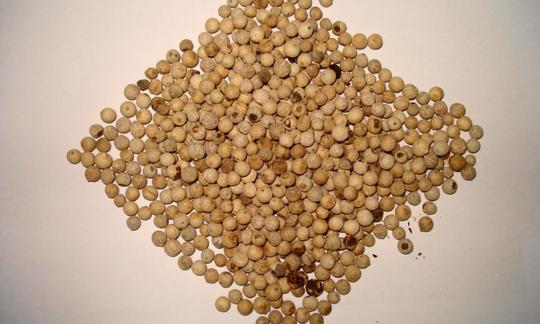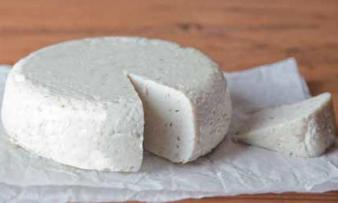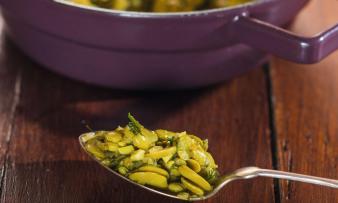Table of contents
White pepper has a sharper taste than other types of pepper. Its white appearance makes it ideal for dishes where a light color is desired. Whether it is raw depends on the production process. It is usually also available organically.
Use in the kitchen
White pepper is produced by skinning fully ripe, red pepper berries. The berries are soaked in running water for about a week to loosen the skin. After this process, mechanical peeling takes place, followed by drying and partial bleaching in the sun. This processing gives the white pepper its color, which makes it the perfect seasoning for light-colored dishes. It is particularly suitable for light sauces, soups, dips (light hummus), stews, casseroles, steamed vegetables (white asparagus, cauliflower, kohlrabi, cultivated mushrooms) where black peppercorns visually influence the dish. 1 A classic is the white pepper sauce, the vegan version of which is prepared with rapeseed oil, flour, plant-based milk (e.g. soy milk) and nutmeg. White pepper is ideal as a spice in the production of vegan cheese alternatives (e.g. vegan almond cheese) or as a pleasant spiciness in potato salad.
With its hotter note compared to other types of pepper, it is a preferred choice for giving dishes a more intense spiciness. White pepper is therefore often used in Asian cuisine. A well-known dish that highlights the delicate aromas of white pepper is fried rice. The white pepper harmonizes perfectly with mixed vegetables such as peppers, carrots, peas and garnished with spring onions and sesame seeds.
Vegan recipe for cream cheese cucumber salad with white pepper
Ingredients (for 2 people): 1 cucumber, 150 g vegan almond cheese, 2 tbsp fresh dill, 2 tbsp lemon juice, 1 tbsp linseed oil, 1 tsp white pepper, salt to taste.
Preparation: Peel the cucumber and cut into thin slices, place in a bowl and lightly salt. Leave to stand for ten minutes and then drain off the resulting water. In a separate bowl, mix the vegan almond cheese with lemon juice, linseed oil, chopped dill and white pepper. Add the cucumber slices to the cream cheese mixture and mix gently to evenly cover the cucumbers. Leave the salad in the fridge for at least 30 minutes to allow the flavors to develop properly. Before serving, add salt to taste and sprinkle with additional freshly ground white pepper.
Vegan recipes with white pepper can be found under the note: " Recipes that have the most of this ingredient ".
| Not only vegans or vegetarians should read this: Vegans often eat unhealthily. Avoidable nutritional errors. |
Purchasing - Storage
White pepper is available all year round because it is imported from tropical countries and the dried pepper berries and powder have a long shelf life.
White pepper is available in most grocery stores and supermarkets such as Coop, Migros, Denner, Volg, Spar, Aldi, Lidl, Rewe, Edeka, Hofer, Billa etc. dried, both as a powder and whole. Organically certified pepper can be purchased in health food stores, organic supermarkets such as Denn's Biomarkt and Alnatura or online.
The availability of white pepper varies depending on the size of the store, catchment area, etc. Our recorded food prices for the DA-CH countries can be found above under the ingredient image - and by clicking you can see their development at various suppliers.
Storage Tips
White pepper is best stored in a cool, dry, dark place and in an airtight container to preserve its freshness and flavors.
Ingredients - Nutritional values - Calories
Here we realistically show you the ingredients of spices and herbs per 1 g (instead of per 100 g as usual).
At a quantity of 1 g, white pepper has an energy value of 2.9 kcal. It contains hardly any fat, protein or fiber and only 0.6 g of carbohydrates per 1 g. 2
Manganese, iron and calcium are the most important essential nutrients contained in white pepper. 2 However, because of the small amount consumed, they and the macronutrients do not contribute significantly to meeting the respective daily requirement. Far more important for the health value are the secondary plant substances in this ingredient, which can have an effect even in trace amounts. Although all herbs and spices have many health-promoting ingredients, we deliberately avoid the insubstantial buzzword superfood here.
The complete ingredients of white pepper, the coverage of the daily requirement and comparison values with other ingredients can be found in our nutrient tables. In the article Nutrients explained you will get a detailed insight into the topic.
Health effects
Is white pepper unhealthy? White peppercorns, like other types of pepper, are extremely beneficial to health. The health effects of pepper are based on its high content of secondary plant substances, in particular the alkaloid piperine, which gives pepper a variety of positive properties. It also contains phenols, flavonoids, piperamides, steroids, lignans, neolignans, terpenes, chalcones and amides. 3,4,5 Since the outer shell of white pepper is removed, the composition and concentration of its bioactive substances differs from other types of pepper, such as black pepper. The amount of phenols and flavonoids, which are particularly concentrated in the shell, is therefore lower in white pepper. In contrast, white pepper contains more piperine than other types of pepper. 6 Studies on the effects of piperine on cells, animals and humans have shown antimicrobial and antioxidant effects as well as therapeutic effects against various types of cancer such as breast cancer, skin cancer, ovarian cancer, colon cancer and leukemia. 7,8,9 Pepper also shows proven anti-inflammatory, analgesic, liver-protective, antidepressant, anticonvulsant and neuroprotective effects. 10,17
A study in China was also able to demonstrate that the administration of fried white pepper, compared to the usual treatment with montmorillonite powder, led to a significant reduction in the frequency of diarrhea in infants and children under 2.5 years of age, especially in patients with acute or persistent diarrhea. 13 In another study, the pepper alkaloid piperine showed an inhibitory effect on the growth of multi-drug resistant (MDR) gram-negative bacteria, including toxigenic Vibrio cholerae, Pseudomonas aeruginosa and strains of Escherichia coli, which are the cause of various gastrointestinal diseases. 14
By increasing the permeability of cell membranes, the piperine contained in pepper also increases the absorption and effectiveness of medications. 9 In laboratory experiments, this effect could be used to increase the death of resistant cancer cells using a combination therapy of pepper and cancer drugs. This effect could be observed in combination treatments of breast cancer, cervical cancer and prostate cancer cells. However, further studies on humans are needed to verify the results outside the laboratory. 10,11,12
Dangers - Intolerances - Side effects
The secondary plant substances and essential oils contained in pepper can cause allergic reactions in some people, which manifest themselves through typical symptoms such as gastrointestinal complaints, respiratory irritation, itching and skin rashes. There are also cross allergies with, for example, mugwort. However, a diagnosed pepper allergy does not necessarily mean that every variety causes symptoms. In general, it is recommended to avoid foods seasoned with pepper if you have a diagnosed allergy. 13
The alkaloid piperine contained in pepper can increase the absorption of drugs by more than double. 12 Although this effect can be used in many medical therapies, it is advisable to be aware of the potential for an increased effect when taking medication and consuming pepper at the same time.
Folk medicine - natural medicine
In Indian and Chinese medicine, pepper is used in many ways as a medicine. Within Indian tradition, pepper is valued for its beneficial effects on digestion, its ability to stimulate the appetite, and its potential therapeutic effects on various ailments such as colds, coughs, breathing difficulties, fever, worm infestations, and hemorrhoids. Pepper is also recommended for relieving toothache, muscle pain, inflammation, and epileptic seizures. In combination with ginger, pepper is a key ingredient in "Trikatu," which aims to promote digestion. 8.25
In Chinese medicine, pepper is used as an antidote for snake and scorpion bites. White pepper is also said to relieve arthritis. To treat arthritis, place 12 white peppercorns under the tongue every morning until saliva collects and then swallow the peppercorns. 15 There are no clinical studies yet to investigate the effects of this form of therapy, but one research study found that the piperine contained in pepper has anti-inflammatory and anti-arthritic effects. 16
Ecological footprint - animal welfare
The ecological footprint of pepper varies due to various factors such as cultivation method, use of pesticides and fertilizers, the natural conditions of the country of cultivation and the means of transport and distances in international trade. Since the origin and production conditions have a significant influence on the environmental impact of pepper cultivation, it is advisable to prefer products from organic farming and with official certifications such as the Sustainable Spices Initiative ( SSI), the National Sustainable Spice Programme India ( NSSP), Fairtrade or the EU organic seal. These guarantee certain sustainability and social standards.
As black pepper is the most widely used pepper in the world, it has been a priority in numerous research studies. For white pepper, we could not find exact figures on the ecological impact of its production, such as the CO 2 footprint or the water footprint. Since black and white pepper are the same plant species, it can be assumed that the impacts of cultivation are comparable. However, it should be noted that more processing steps are required to produce white pepper, which could increase its environmental impact. On average, the global CO 2 footprint of black pepper is 4.69 kg CO 2 eq/kg (2021: 4.3 kg CO 2 eq/kg), 18 while the average water footprint is 7611 liters of water per kilogram. This is significantly lower compared to other spices such as cinnamon (15,526 liters/kg), cardamom (34,319 liters/kg) or cloves (61,205 liters/kg). 19
Pepper is often grown in combination with various "support trees" on which the pepper plants grow. Wooden stakes are also used to support the pepper plants. The ecological impact of pepper cultivation varies depending on the cultivation method chosen and the type of support tree. Growing pepper with trees proves to be more cost-effective, productive and sustainable in the long term compared to using stakes, as the trees can be used for other purposes. Support trees also have the potential to bind CO 2 and increase soil fertility through closed nutrient cycles, which leads to an improved CO 2 balance and soil quality and reduces the ecological footprint. 20
Worldwide distribution - cultivation
Pepper, also known as the "king of spices", is the most important internationally traded spice. Green pepper ( Piper nigrum) is believed to have originally originated in the foothills of the Himalayas or southwest India. Piper wightii and P. galeatum are thought to be the most likely ancestors of cultivated pepper. 25 Pepper cultivation spread about 1000 years ago with the expansion of Indian culture into Southeast Asia, to what is now Indonesia and Malaysia. Pepper thrives best in hot and humid conditions, which is why it is now grown in the southern Indian peninsula as well as other countries in South and Southeast Asia and South America. Vietnam is currently the world's largest producer of pepper, followed by Indonesia, India and Brazil. Pepper production in India has gradually declined over time since countries such as Vietnam and Indonesia began to grow pepper more. 7,21
Industrial production
The pepper available in stores is a processed product and its production requires several steps. The color of the peppercorns and pepper powder varies depending on the time of harvest and the type of processing:
Green peppercorns are fully developed but unripe berries that can be enjoyed fresh or preserved in brine, vinegar or citric acid. Alternatively, green pepper can be dried, dehydrated or frozen to preserve it for a longer period of time. Unlike black or white pepper, green pepper has a limited market because it can quickly change color when stored unless preserved. Black pepper is produced by drying the ripe green berries and is used mainly in four forms: whole grains, powder, oil and oleoresin. Most countries import whole peppercorns and then process them into powder. 1
White pepper is made from peeled peppercorns. White peppercorns are the light-colored inner kernels of pepper berries, which are obtained by removing the pericarp (outer skin). To make white pepper, you use either fully ripe red berries or peeled black peppercorns:
- The red, ripe berries are separated from the stem and packed in jute sacks. The sacks are then soaked in slowly running water until the pericarp is loose enough to be removed by rubbing after about one to two weeks. Alternatively, fermentation tanks are used, although this method requires changing the water every day. After removing the pericarp, the berries are washed and dried in the sun or using dryers to reduce the moisture content. 25 kg of white peppercorns can be produced from 100 kg of ripe berries. Another method of producing white pepper is the CFTRI method: fully ripe but unripe berries are boiled in water for 10 to 15 minutes to soften the skin. After cooling, the skin is rubbed off mechanically or manually, the berries are washed and left to dry in the sun. Because the CFTRI method does not require fermentation, the grains remain free of unpleasant odors. However, because this method involves gelatinization of starch, the powder obtained is not pure white as with the traditional method, but rather a powder with a light brown color. 1,24
- The second method of producing white pepper is to use black peppercorns that are mechanically peeled of their outer skin. This method is usually used when white pepper is in short supply. The appearance of the peeled seeds is inferior to that of traditionally produced white peppercorns, but they are satisfactory when ground. Grinding is also more difficult with this method, as volatile oils can easily be lost. 24
As with black pepper, white peppercorns are either sold directly or processed into white pepper powder. 24
Further information
White pepper, botanically known as Piper nigrum, belongs to the Piperaceae family and is a flowering, woody, perennial climbing plant. 4 The Piper genus includes over a thousand species with many different sizes and growth forms. 23
Found in the wild
Wild pepper can be found in the mountains of India (Western Ghats). Wild pepper is usually dioecious, meaning that female and male flowers grow on different plants. 25
Alternative names
In addition to the term 'white pepper', the expression 'white peppercorns' is also used. Due to its widespread use, pepper is also known as the "king of spices".
In English, white pepper is called white pepper or white peppercorns.
Other uses
Due to its antimicrobial and antioxidant properties, pepper has been used for centuries to preserve food. Both whole peppercorns and pepper essential oil serve this purpose. 1,22
Pepper is also used in agriculture as a biological fungicide and insecticide to protect plants. As an insect repellent, pepper acts as a neurotoxin-like agent that paralyzes insects. The advantages of using it as an insecticide are its low toxicity for mammals and the rapid degradation of the pepper substances in sunlight, which ensures minimal environmental impact. The antimicrobial properties of pepper and its effect as an insect repellent are also used on humans and animals, as well as in the home. 4,10











Comments